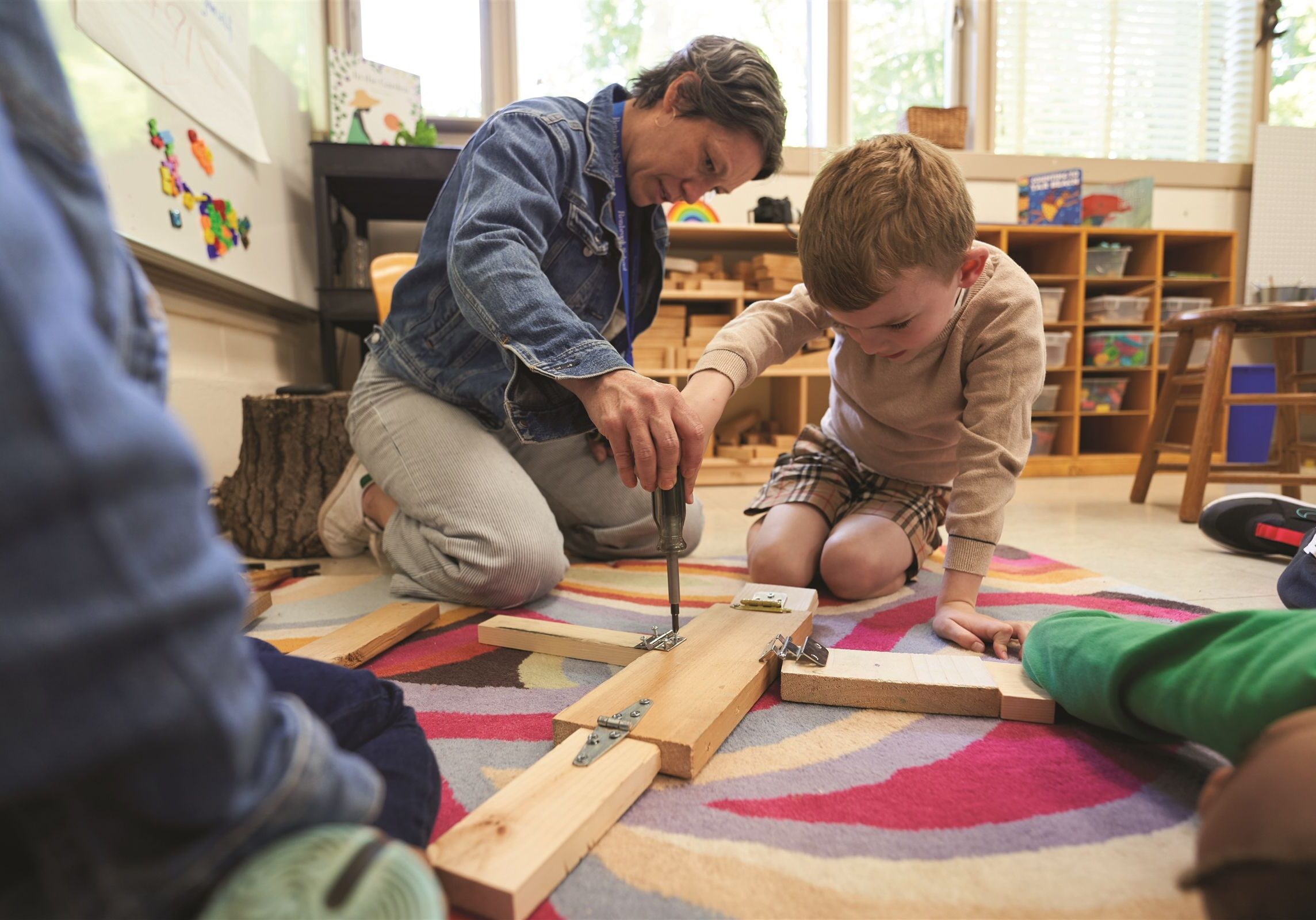Scientific Thinking from the Beginning

Forming questions clearly and precisely is an essential skill and the first step in scientific thinking. Then children need the tools to pursue their inquiry. Beginning School students bring nature into their classrooms, where they use magnifiers, microscopes, and measuring tools to observe and track small changes. In one experiment, three-year-olds placed pumpkin seeds in clear boxes, some with soil, some without, and watched what happened.
Using all five senses, the children make comparisons. As they develop keen observational skills, they acquire the descriptive vocabulary they need to communicate their findings. By Kindergarten, they are comparing, contrasting, and categorizing.
Probing to learn more about the natural world that surrounds our Beginning School trains children in scientific habits of thinking and gives them tools for further study. But the benefits of their copious time outdoors go even deeper. The sounds of nature and the freedom of movement they experience reduce stress. They develop compassion for all living things, even slugs and spiders, meeting them with curiosity instead of judgment. And they take a sense of home with them into Lower and Upper School. As Howard Wright, Upper School Science Department Head, observes, when children know their immediate environment intimately, they have a basis for learning about other, more distant environments and the people who live there. Their relationship with the Renbrook forest trains them to understand the wider world.
Gardening begins in Preschool. The children love planting seeds and watching them grow. They learn what the plants need to thrive. They learn that they must pay careful attention to tending the growing plants. And they learn that the work they do can help someone. All their produce goes either to the Renbrook kitchen or to Gifts of Love, a non-profit in Hartford that provides food assistance to struggling families. Junior Kindergartners harvest food they planted as Preschoolers in raised beds near the kitchen. They keep journals, documenting their observations with drawings. In Kindergarten, they will write in their journals.
Dr. Kelly Bird, Director of Beginning School, is excited, too, about the evolving STEAM curriculum, with a focus on choosing materials and learning how they can be used. STEAM is an acronym for Science, Technology, Engineering, Art, and Math. It is a multidisciplinary approach that invites students to invent solutions to real world problems, hands-on. In Dr. Bird’s STEAM classes with Kindergartners, she takes them from two-dimensional to three-dimensional construction, using connectors, braces, and circuitry.
“How do you make things move?” And the Kindergarten students are off. They make animals from oaktag, attaching their limbs with brads. Then they create structures with Makedoo, an open-ended system of tools for creative cardboard construction. Next, they tackle woodworking, using screws, hammers, and hinges to make animals with moving parts. They learn simple coding to make robots move.
The process is filled with trial and error. Students grapple with what doesn’t work and how to move on. “What was a problem you ran into, and how did you solve it?” their teacher asks. Misfires and mistakes are learning points, not failures. Dr. Bird’s students are champions, bold, and excited about problem-solving.
Our youngest students are on a path of discovery, developing the scientific skills of analysis and synthesis and working together to form conclusions based on carefully gathered evidence. And throughout Preschool, Junior Kindergarten, and Kindergarten, they are becoming confident communicators, verbally and eventually in writing, as they explain their processes.
Science Friday with Mrs. Hesnan and Ms. Blenman
Kim Hesnan and Andrea Blenman gather their excited three-year-olds in a circle on the rug for Science Friday. During the next half-hour, Mrs. Hesnan will help them construct the head of the papier maché bear they are building as part of their study of black bears. There are many steps, she explains, and each child will have a turn, crumpling tissue paper, wrapping, taping, and gluing.
Questions come from the teacher and from the children.
As they construct the ears, “What are bears listening for?”
“Why did you mix water with the glue?”
“Mrs. Hesnan, did your mom and dad let you use glue?”
“What did we use?” “Paper!”
“What kind of paper?” “Tissue paper!”
The rapt children postulate, “I think it’s real!” And debate, “I don’t think it’s real!” After reviewing the process they have just executed, Mrs. Hesnan asks them to think about next steps, “Do you think we should take him outside?” A child interjects, “I think we should!”
The children name the bear Brownie A. Go-ee.
“Where does he live?” “In West Hartford!”
“What is his home?” “A cave!” “A den!” “A castle!” “A school!”
They take a vote: shall we make him a cave or a den? They discuss what materials they would need for each and decide on a cave, because the dirt they would have to dig for a den would get their hands dirtier than the rocks they’ll use for a cave! The circle has become more crowded and wigglier as the children lean in to participate. Now it’s time for snack.